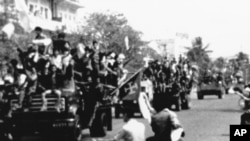The final battle between U.S. forces and the Khmer Rouge took place on the tiny island of Koh Tang on May 15, 1975, nearly a month after Phnom Penh fell to the regime. A brief but fierce battle, U.S. forces had been sent to rescue the passengers of a U.S. merchant ship: the Mayaguez.
More than 43 years since the attempted rescue operation, the sacrifice made by those sent to Koh Tang has not been adequately honored, according to survivors and researchers.
On May 12, 1975, Cambodian gunboats intercepted the US merchant ship Mayaguez in Cambodian waters and forced it to dock at Koh Tang island. The incident sparked an international crisis.
The Mayaguez carried 274 containers, 77 of which belonged to the US government and military. The materials were taken from the US embassy in Saigon just nine days before the US-backed government in Vietnam fell.
US President Gerald Ford authorized a military operation to rescue the captive sailors and the cargo ship. The operation involved 179 marines and eight helicopters launching from the U-Tapao military base in Thailand. The battle lasted for 14 hours, from dawn until dark.
“It was really weird because when we came on the island everybody thinks the helicopter comes and touches down, lands, and everybody runs out or jumps out,” retired staff sergeant Fofomaitulagi Tuitele told VOA Khmer in an interview. “But that was not the case.”
Tuitele, known among his friends as Fofo Tuitele or “Staff sergeant T” recalled fierce resistance from the Khmer Rouge occupying the island. The marines were under heavy fire, making it hard for helicopters to land.
“I’ve never seen any helicopter land a couple of feet up from the ground and we’re still moving so you have to jump out and run,” said Tuitele.
All the 40 sailors were safely released, but 41 US servicemen were killed with three missing in action and presumed dead, and 50 others wounded. Three helicopters were destroyed.
The US could have suffered heavier casualties if not for the bravery of soldiers like Tuitele, who made his way to the Khmer Rouge’s heavy gun positions to silence them to pave the way for helicopters’ safe landing.
“He went up in there and he heard a gun fire in one position and then it was stopped,” retired marine Al Bailey told VOA Khmer. “And then he would hear the next position. He’d hear some gunfire and then it would stop. And then he went to the third position and it stopped. I’m gonna say it took him about half an hour or twenty minutes.”
When Tuitele returned he brought with him two AK-47 rifles, canteens, binoculars, sandals, cigarettes, and other loot.
“And that changed the whole tide of the battle ... it slowed down, the gunfire slowed down, and then we got more airstrikes in and we got more helicopters in,” said Bailey.
Tuitele did it all by himself.
“I don’t have to worry about keeping that person’s life and stuff. I can react real quick than trying to tell somebody what to do and what not to do if I go by myself. I can think what I’m going to do. I don’t have to say anything. I can be real quiet,” Tuitele said.
The majority of the fighters were young recruits aged between 18 and 21. Some of them were still in training.
But their fighting spirit was strong.
“I can say that they were brave,” Em Son, former Khmer Rouge commander at Koh Tang, later told Peter Maguire, a researcher. “They were not afraid of being killed.”
The Khmer Rouge lost between 13 to 25 men.
Scholars still debate the specifics of the rescue operation, for instance, the use of inexperienced fighters, intelligence failures, and misinforming the US public about the real situation of the kidnapping, as the captives had been released before the Marines landed on the island.
“In many ways, it was an unnecessary military operation,” said Maguire, who is also the Fainting Robin Foundation’s president. “They were sent to an island to free a captured American merchant marine ship. By the time they landed on the island, the ship had already been freed. So there was really no point in them even being on the island. It’s very easy to look at it backward and criticize all the decisions that were made, but in any event, to be even very gentle, it was a mess.”
Even more than 43 years later, recognition has not been adequately given to those who died and those who survived the incident, according to Maguire.
In 2016, Congressman Mark Meadows (R-NC) and Congresswoman Tulsi Gabbard (D-HI) introduced a bill to award veterans of the Mayaguez rescue operation the Vietnam Service Medal, but it failed to pass through Congress despite their names being engraved at the Vietnam Veterans Memorial in Washington D.C.
“I don’t know why,” said Maguire. “I don’t understand why their names are on the wall here but they don’t have the Vietnam Service Medals.”
Maguire said his foundation is spearheading another process to get Congress to award the medal. He believes that Tuitele deserves the Navy Cross or Congressional Medal of Honor.
Tuitele joined the Marines when he was 18, serving in Golf Company 2/9, 3rd Marine Regiment. He served two tours in Vietnam, which earned him the Bronze Star and Purple Heart. He left after 23 years and worked at the US Postal office for almost 20 years before retiring to Rio Rancho, New Mexico. He was born in Vailoa, Savai'i, Samoa, and became a US citizen in 2016.












